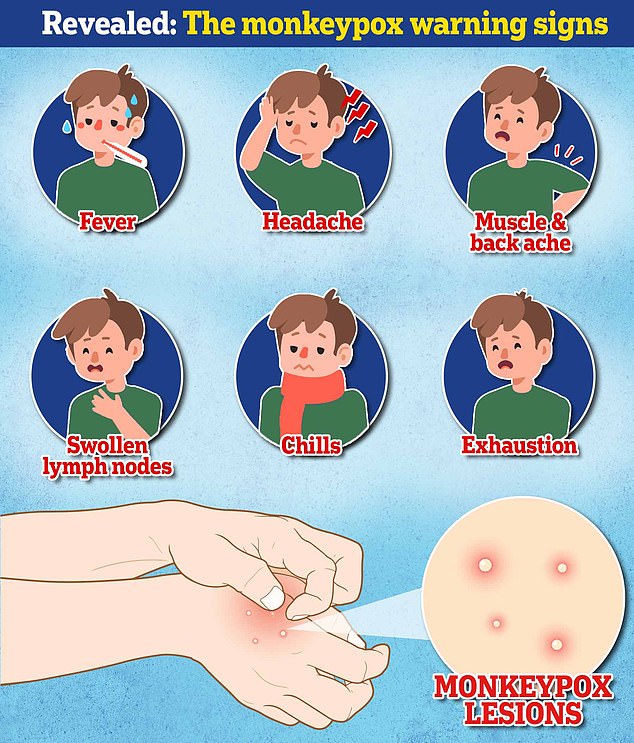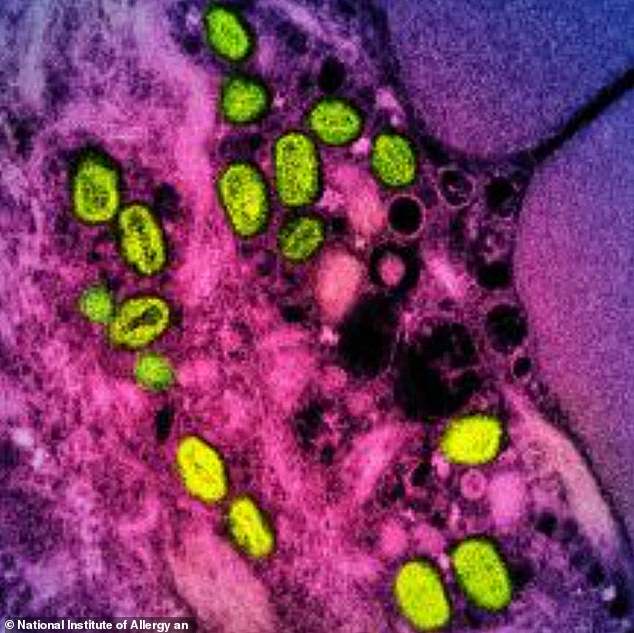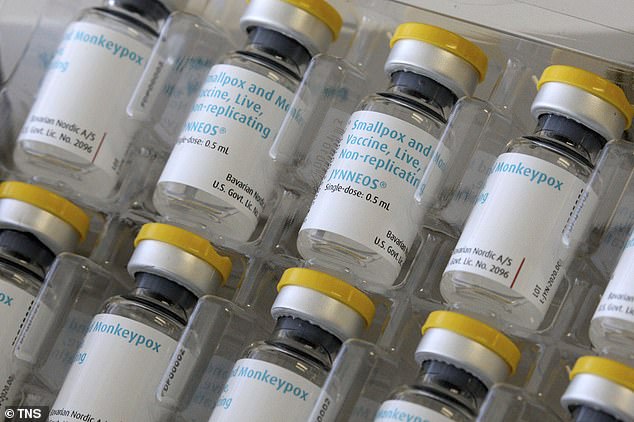Mpox Q&A: From the subtle warning signs, to how to stay protected… everything you need to know about the deadly variant soon to land on UK shores








A new deadly strain of mpox has officially reached Europe and could soon reach the UK, leading infectious disease experts have warned.
The clade 1b mutation, which experts have called ‘ the most dangerous one so far’, is believed to be behind a wave of miscarriages, and kills one in ten of those infected.
Sweden has reported its first case of the new deadly form, marking the first time it has been found outside of Africa.
Yesterday the World Health Organization (WHO) also declared the ongoing mpox outbreak a global public health emergency for the second time in two years.
The UK Health Security Agency (UKHSA) has already announced it is ‘already planning’ for UK cases.
So just how worried should we be, who is most at risk, and what, if anything, should we do to protect ourselves?
Here MailOnline explains everything you need to know.


This map shows areas where cases of the new mpox strain has been confirmed (shaded in red) and those where nations deemed to be at risk of cases emerging according to UK health officials
What is mpox?
Mpox, formerly known as monkeypox, is a viral infection once mainly confined to west and central Africa.
The WHO renamed monkeypox in 2022 to restrain what it called ‘racist and stigmatising language’ surrounding the infection.
Mpox was spread to humans through direct contact with animals such as squirrels, which are known to harbour the virus.
However, it can also be transmitted through very close contact with an infected person, most commonly via sex.
However, mpox isn’t considered a sexually transmitted disease, because it also spreads via other forms of close contact, such as skin-to-skin contact or sharing towels, clothing or bedding with someone who has the virus.
The virus was first discovered when an outbreak of a pox-like disease occurred in monkeys kept for research in 1958, hence the previous name.
The first human case was recorded in 1970 in the Democratic Republic of Congo (DRC) and the infection has been reported in mainly central and western African countries since then.
In 2022, an outbreak in Europe and the US that largely affected gay and bisexual men, prompted the World Health Organization (WHO) to declare a public health emergency.
It was the first time mpox had been reported to have primarily spread via sexual contact.
More than 17,000 cases and 571 deaths have been logged in Africa this year, officials have said, a 160 percent surge compared to the same period last year.
What is the new strain?
Clade 1b is a descendent of the deadly clade 1 strain of mpox and different than the milder version (clade 2) which spread to more than 20 countries, including the UK, in 2022.
Once again, sexual transmission seems to be the primary way clade 1b is spreading.
Researchers believe Clade 1b emerged in September last year, with the first cases found in sex workers in the DRC mining town of Kamitug, around 170 miles from the border with Rwanda.
Clade 1 has historically only been found in people who eat infected bushmeat, with transmission largely confined to the affected household.

Mpox, formerly known as monkeypox, is a rare viral infection which people usually pick up in the tropical areas of west and central Africa. Pictured, a colorized transmission electron micrograph of monkeypox particles (green) found within an infected cell (pink and purple)

It is a far cry from the 2022 outbreak where thousands of cases were recorded, mostly in London
How is it different to other strains?
Scientists have previously warned the strain was ‘undoubtedly’ the ‘most dangerous one’ yet, and there is some evidence that it is more contagious.
Although it is currently not entirely clear how fast the new strain spreads.
Like Clade 2, Clade 1b causes a severe blister-like rash at the site of the infection.
But symptoms are more severe, with the rash often spreading to the entire body.
The emergence of a new mutant strain, or clade, is concerning as it indicates the virus is adapting and getting better at spreading from person to person.
The number of asymptomatic cases or people with minimal symptoms, who could still potentially spread the infection, is also still unknown.
Where has the mutant form of the virus been found?
Thousands of cases of the disease and hundreds of deaths have already been reported in DRC this year.
In recent weeks, infections have begun to spread to other neighbouring countries across East and Central Africa.
Since mpox Clade 1b was first witnessed in DRC there have been confirmed cases in Burundi, Kenya and Rwanda, before the new case identified in Sweden.
And in the past month, at least 50 mpox cases have been reported in four other countries bordering the DRC — countries that have not experienced the virus previously.
Yesterday, Olivia Wigzell, director-general at the Swedish public health agency told a press conference the country’s first clade 1b case was infected while in a part of Africa where there was a large outbreak of the disease.
Magnus Gisslen, a state epidemiologist also added the patient had ‘received care’ but gave no further details of their condition.
How deadly is it?
Mpox is usually not serious, with most patients recovering within a few weeks without treatment. Yet, the disease can prove fatal.
Estimates suggest the new mutant strain has a mortality rate of five per cent for adults and 10 per cent for children.
But another worrying aspect was infection in pregnant women was causing an ‘alarming’ number of miscarriages.
Experts have also previously said some cases had even resulted in irreversible sight loss, as well as recurrent whole-body rashes.
Declaring a public health emergency this week, the WHO said the ‘rapid spread’ of the new clade was ‘very worrying’.

This map shows the location of mpox cases by UK nation between January 2023 and as of the end of July this year

After clade 2 sparked alarm among health officials globally in 2022, new infections gradually tapered off amid boosted awareness of the disease and a hurried vaccination program. At the time the UK reported almost 4,000 cases, with NHS England inoculating over 68,000 people against the disease with the smallpox vaccine. Pictured, long lines to receive the vaccine
How does it spread and what can you do to protect yourself?
Mpox is not classified a sexually transmitted infection, though it can be passed on by direct contact during sex.
Contagious lesions, through which infections are most likely to be passed on, can appear on any part of the body.
The infection can also be passed on through contact with clothing or linens used by an infected person.
According to the WHO, if someone you know is diagnosed with or has suspected mpox, avoid close contact with them, including sexual contact.
If you have symptoms, seek health advice and self-isolate while you wait to get tested.
Clean and disinfect environments that could have been contaminated with the virus from someone who is infectious.
The US Centers for Disease Control and Prevention (CDC) also says smallpox vaccines and antivirals can be used to treat mpox as well as control it.
What is a global health emergency and why was one declared?
A ‘public health emergency of international concern’ or PHEIC is the WHO’s highest form of alert.
They are declared when diseases are spreading in new or unusual ways, and are aimed at galvanising international co-operation and funding to tackle an outbreak.
It is the second time in two years that the WHO has declared an mpox outbreak a global public health emergency.
‘It’s clear that a coordinated international response is needed to stop these outbreaks and save lives’, WHO Director-General Dr Tedros Adhanom Ghebreyesus said.
The WHO’s declaration also follows a similar warning published by the Africa Centres for Disease Control and Prevention earlier this week.
What are the symptoms people should be aware of?
Initially, mpox causes a flu-like illness: fever, headache, sore muscles, back pain, swollen lymph nodes (glands found in the neck, groin or under the arms) and fatigue.
Within one to five days, a rash appears, usually first on the face, then spreading to other parts of the body, including the genitals.
The rash is similar to chickenpox. It starts as raised spots that then turn into small fluid-filled blisters. These blisters turn into scabs, which eventually fall off.
The illness can last up to four weeks, but most cases clear up on their own without any treatment.
During the last outbreak, the UK Health Security Agency advised anyone with unusual rashes or lesions on any part of the body – in particular, gay or bisexual men, those who have been in contact with someone who has or might have mpox, and anyone who’s travelled to West Africa in the past three weeks – to contact NHS 111 or phone their local sexual health service.

The smallpox vaccine works due to the two viruses being closely related. But experts said there wasn’t yet enough evidence to suggest a vaccine would be effective against this new strain
How likely is it to reach the UK?
Infectious disease experts have warned it is probable clade 1b will reach the UK and could lead to British deaths.
The city of Goma in the DRC has an international airport providing frequent direct flights to Europe — which experts have previously warned is a possible path for the virus to enter a new continent.
And Kenya, which has also been struck by the outbreak has direct 9-hour flights from Nairobi to London.
Professor Paul Hunter, an expert in infectious diseases from the University of East Anglia, told MailOnline: ‘It probably will spread to Europe, but that doesn’t mean we should stop trying to control it now.’
He added that while the new mpox strain could lead to fatalities in developed nations, they could be lower due to better access to a higher standard of health care.
However, he said there was reason for optimism, as given countries managed to control the 2022 spread of the clade II strain, nations could use the same measures against clade I.
Meanwhile, Dr Simon Clarke, an infectious disease expert University of Reading, said while people shouldn’t panic, mpox will likely reach the UK.
‘All countries should be aware of the risk that this new variant of the virus will spread, indeed it’s already doing so in Africa and likely find its way to Europe and the UK in due course, so it’s important that authorities in the developed world assist with containing this wave of infections,’ he said.
‘This will spread beyond Africa and may already have begun to do so, but nobody really knows to what extent.’
Thankfully he said it is unlikely we will see anything near the same level of travel restrictions as during Covid, but added that health systems like those in the UK still need to prepare for cases.
The UK Health Security Agency (UKHSA) yesterday announced it was ‘already planning’ for UK cases.
Dr Meera Chand, deputy director at the UK health Security Agency, said the current threat to the UK by the new mpox strain is ‘currently considered low’.
But she added: ‘However, planning is underway to prepare for any cases that we might see in the UK.
‘This includes ensuring that clinicians are aware and able to recognise cases promptly, that rapid testing is available, and that protocols are developed for the safe clinical care of people who have the infection and the prevention of onward transmission.’
What happens if someone does test positive in the UK?
If a person is suspected to have monkeypox in the UK, they usually will be given a PCR test – similar to the ones that were used to pick up Covid.
These use swabs taken from the skin and throat.
There are no specific treatments, and the NHS currently says if symptoms are mild, patients may simply be advised to stay at home until they recover.
If the illness is more serious, patients may be offered treatment including antiviral medication — Tecovirimat, which was designed for smallpox, and Cidofovir.
Will the current vaccine work against it?
After clade 2 sparked alarm among health officials globally in 2022, new infections gradually tapered off amid boosted awareness of the disease and a hurried vaccination program.
At the time the UK reported almost 4,000 cases, with NHS England inoculating over 68,000 people against the disease with the smallpox vaccine.
This works due to the two viruses being closely related.
According to the European Centre for Disease Control, data on clade-specific vaccine effectiveness is currently limited.
But public health experts say, because the two strains are 90 per cent similar, they expect the vaccine to work against clade one.
Trials will be needed to work this out, which will take time, they added.




